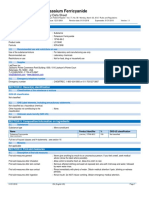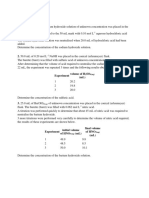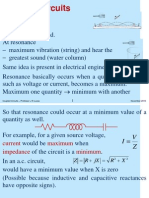SDS Citric Acid
SDS Citric Acid
Uploaded by
Zeeshan KhanCopyright:
Available Formats
SDS Citric Acid
SDS Citric Acid
Uploaded by
Zeeshan KhanOriginal Description:
Copyright
Available Formats
Share this document
Did you find this document useful?
Is this content inappropriate?
Copyright:
Available Formats
SDS Citric Acid
SDS Citric Acid
Uploaded by
Zeeshan KhanCopyright:
Available Formats
Citric Acid, Anhydrous
Safety Data Sheet
according to Federal Register / Vol. 77, No. 58 / Monday, March 26, 2012 / Rules and Regulations
Date of issue: 10/24/2007 Revision date: 04/04/2017 Supersedes: 06/19/2013 Version: 1.1
SECTION 1: Identification
1.1. Identification
Product form : Substance
Substance name : Citric Acid, Anhydrous
CAS No : 77-92-9
Product code : LC13140
1.2. Relevant identified uses of the substance or mixture and uses advised against
Use of the substance/mixture : For laboratory and manufacturing use only.
Recommended use : Laboratory chemicals
Restrictions on use : Not for food, drug or household use
1.3. Details of the supplier of the safety data sheet
LabChem Inc
Jackson's Pointe Commerce Park Building 1000, 1010 Jackson's Pointe Court
Zelienople, PA 16063 - USA
T 412-826-5230 - F 724-473-0647
info@labchem.com - www.labchem.com
1.4. Emergency telephone number
Emergency number : CHEMTREC: 1-800-424-9300 or 011-703-527-3887
SECTION 2: Hazard(s) identification
2.1. Classification of the substance or mixture
GHS-US classification
Serious eye damage/eye irritation Category 2A H319
Full text of H statements : see section 16
2.2. Label elements
GHS-US labeling
Hazard pictograms (GHS-US) :
GHS07
Signal word (GHS-US) : Warning
Hazard statements (GHS-US) : H319 - Causes serious eye irritation
Precautionary statements (GHS-US) : P264 - Wash exposed skin thoroughly after handling
P280 - Wear eye protection
P305+P351+P338 - If in eyes: Rinse cautiously with water for several minutes. Remove contact
lenses, if present and easy to do. Continue rinsing
P337+P313 - If eye irritation persists: Get medical advice/attention
2.3. Other hazards
Other hazards not contributing to the : None.
classification
2.4. Unknown acute toxicity (GHS US)
Not applicable
SECTION 3: Composition/Information on ingredients
3.1. Substances
Substance type : Mono-constituent
Name Product identifier % GHS-US classification
Citric Acid, Anhydrous (CAS No) 77-92-9 100 Eye Irrit. 2A, H319
(Main constituent)
04/04/2017 EN (English US) Page 1
Citric Acid, Anhydrous
Safety Data Sheet
according to Federal Register / Vol. 77, No. 58 / Monday, March 26, 2012 / Rules and Regulations
Full text of hazard classes and H-statements : see section 16
3.2. Mixtures
Not applicable
SECTION 4: First aid measures
4.1. Description of first aid measures
First-aid measures general : Never give anything by mouth to an unconscious person. If you feel unwell, seek medical
advice (show the label where possible).
First-aid measures after inhalation : Allow victim to breathe fresh air. Allow the victim to rest.
First-aid measures after skin contact : Remove affected clothing and wash all exposed skin area with mild soap and water, followed
by warm water rinse.
First-aid measures after eye contact : Rinse cautiously with water for several minutes. Remove contact lenses, if present and easy to
do. Continue rinsing. If eye irritation persists: Get medical advice/attention.
First-aid measures after ingestion : Rinse mouth. Do NOT induce vomiting. Obtain emergency medical attention.
4.2. Most important symptoms and effects, both acute and delayed
Symptoms/injuries after inhalation : May cause respiratory irritation.
Symptoms/injuries after skin contact : Slight irritation.
Symptoms/injuries after eye contact : Causes serious eye irritation.
Symptoms/injuries after ingestion : Nausea.
Chronic symptoms : Affection/discolouration of the teeth.
4.3. Indication of any immediate medical attention and special treatment needed
None.
SECTION 5: Firefighting measures
5.1. Extinguishing media
Suitable extinguishing media : Foam. Dry powder. Carbon dioxide. Water spray. Sand.
Unsuitable extinguishing media : Do not use a heavy water stream.
5.2. Special hazards arising from the substance or mixture
Fire hazard : Not flammable.
Explosion hazard : Not applicable.
Reactivity : None.
5.3. Advice for firefighters
Firefighting instructions : Use water spray or fog for cooling exposed containers. Exercise caution when fighting any
chemical fire. Prevent fire-fighting water from entering environment.
Protection during firefighting : Do not enter fire area without proper protective equipment, including respiratory protection.
SECTION 6: Accidental release measures
6.1. Personal precautions, protective equipment and emergency procedures
6.1.1. For non-emergency personnel
Emergency procedures : Evacuate unnecessary personnel.
6.1.2. For emergency responders
Protective equipment : Equip cleanup crew with proper protection.
Emergency procedures : Ventilate area.
6.2. Environmental precautions
Prevent entry to sewers and public waters. Notify authorities if liquid enters sewers or public waters.
6.3. Methods and material for containment and cleaning up
Methods for cleaning up : On land, sweep or shovel into suitable containers. Minimize generation of dust. Store away
from other materials.
6.4. Reference to other sections
See Heading 8. Exposure controls and personal protection.
04/04/2017 EN (English US) 2/6
Citric Acid, Anhydrous
Safety Data Sheet
according to Federal Register / Vol. 77, No. 58 / Monday, March 26, 2012 / Rules and Regulations
SECTION 7: Handling and storage
7.1. Precautions for safe handling
Precautions for safe handling : Wash hands and other exposed areas with mild soap and water before eating, drinking or
smoking and when leaving work. Provide good ventilation in process area to prevent formation
of vapor.
Hygiene measures : Wash exposed skin thoroughly after handling.
7.2. Conditions for safe storage, including any incompatibilities
Storage conditions : Keep only in the original container in a cool, well ventilated place away from : incompatible
materials. Keep container closed when not in use.
Incompatible products : Strong bases. Strong oxidizers.
Incompatible materials : Sources of ignition. Direct sunlight.
SECTION 8: Exposure controls/personal protection
8.1. Control parameters
No additional information available
8.2. Exposure controls
Appropriate engineering controls : Emergency eye wash fountains should be available in the immediate vicinity of any potential
exposure.
Personal protective equipment : Gloves. Safety glasses.
Hand protection : Wear protective gloves.
Eye protection : Chemical goggles or safety glasses.
Respiratory protection : Respiratory protection not required in normal conditions.
Other information : Do not eat, drink or smoke during use.
SECTION 9: Physical and chemical properties
9.1. Information on basic physical and chemical properties
Physical state : Solid
Appearance : White powder or lumps.
Color : white
Odor : Odorless
Odor threshold : No data available
pH : 1.7 10% solution
Melting point : 153 °C
Freezing point : No data available
Boiling point : 175 °C
Flash point : No data available
Relative evaporation rate (butyl acetate=1) : No data available
Flammability (solid, gas) : Non flammable.
Vapor pressure : No data available
Relative vapor density at 20 °C : No data available
Relative density : No data available
Specific gravity / density : 1.665 g/cm³
Molecular mass : 192.12 g/mol
Solubility : Soluble in water. Soluble in ethanol. Soluble in ether.
Water: 59.2 %
Log Pow : No data available
Auto-ignition temperature : No data available
04/04/2017 EN (English US) 3/6
Citric Acid, Anhydrous
Safety Data Sheet
according to Federal Register / Vol. 77, No. 58 / Monday, March 26, 2012 / Rules and Regulations
Decomposition temperature : 175 °C
Viscosity, kinematic : No data available
Viscosity, dynamic : No data available
Explosion limits : No data available
Explosive properties : No data available.
Oxidizing properties : None.
9.2. Other information
No additional information available
SECTION 10: Stability and reactivity
10.1. Reactivity
None.
10.2. Chemical stability
Not established.
10.3. Possibility of hazardous reactions
Not established.
10.4. Conditions to avoid
Direct sunlight. Extremely high or low temperatures.
10.5. Incompatible materials
Strong acids. Strong bases.
10.6. Hazardous decomposition products
fume. Carbon monoxide. Carbon dioxide.
SECTION 11: Toxicological information
11.1. Information on toxicological effects
Likely routes of exposure : Inhalation; Skin and eye contact; Ingestion
Acute toxicity : Not classified
Citric Acid, Anhydrous (77-92-9)
LD50 oral rat 5400 mg/kg
ATE US (oral) 5400.000 mg/kg body weight
Skin corrosion/irritation : Not classified
pH: 1.7 10% solution
Serious eye damage/irritation : Causes serious eye irritation.
pH: 1.7 10% solution
Respiratory or skin sensitization : Not classified
Germ cell mutagenicity : Not classified
Based on available data, the classification criteria are not met
Carcinogenicity : Not classified
Reproductive toxicity : Not classified
Based on available data, the classification criteria are not met
Specific target organ toxicity – single exposure : Not classified
Specific target organ toxicity – repeated : Not classified
exposure
Aspiration hazard : Not classified
Potential Adverse human health effects and : Based on available data, the classification criteria are not met.
symptoms
Symptoms/injuries after inhalation : May cause respiratory irritation.
Symptoms/injuries after skin contact : Slight irritation.
Symptoms/injuries after eye contact : Causes serious eye irritation.
Symptoms/injuries after ingestion : Nausea.
04/04/2017 EN (English US) 4/6
Citric Acid, Anhydrous
Safety Data Sheet
according to Federal Register / Vol. 77, No. 58 / Monday, March 26, 2012 / Rules and Regulations
Chronic symptoms : Affection/discolouration of the teeth.
SECTION 12: Ecological information
12.1. Toxicity
Citric Acid, Anhydrous (77-92-9)
LC50 fish 1 440 mg/l
EC50 Daphnia 1 1534 mg/l
12.2. Persistence and degradability
Citric Acid, Anhydrous (77-92-9)
Persistence and degradability Not established.
12.3. Bioaccumulative potential
Citric Acid, Anhydrous (77-92-9)
Bioaccumulative potential Not established.
12.4. Mobility in soil
No additional information available
12.5. Other adverse effects
Other information : Avoid release to the environment.
SECTION 13: Disposal considerations
13.1. Waste treatment methods
Waste disposal recommendations : Dispose in a safe manner in accordance with local/national regulations.
Ecology - waste materials : Avoid release to the environment.
SECTION 14: Transport information
Department of Transportation (DOT)
In accordance with DOT
Not regulated
SECTION 15: Regulatory information
15.1. US Federal regulations
Citric Acid, Anhydrous (77-92-9)
Listed on the United States TSCA (Toxic Substances Control Act) inventory
All components of this product are listed, or excluded from listing, on the United States Environmental Protection Agency Toxic
Substances Control Act (TSCA) inventory
This product or mixture does not contain a toxic chemical or chemicals in excess of the applicable de minimis concentration as specified in 40
CFR §372.38(a) subject to the reporting requirements of section 313 of Title III of the Superfund Amendments and Reauthorization Act of 1986
and 40 CFR Part 372.
15.2. International regulations
CANADA
Citric Acid, Anhydrous (77-92-9)
WHMIS Classification Class D Division 2 Subdivision B - Toxic material causing other toxic effects
EU-Regulations
No additional information available
National regulations
No additional information available
15.3. US State regulations
California Proposition 65 - This product does not contain any substances known to the state of California to cause cancer,
developmental and/or reproductive harm
04/04/2017 EN (English US) 5/6
Citric Acid, Anhydrous
Safety Data Sheet
according to Federal Register / Vol. 77, No. 58 / Monday, March 26, 2012 / Rules and Regulations
SECTION 16: Other information
Revision date : 04/04/2017
Other information : None.
Full text of H-phrases: see section 16:
------ H319 Causes serious eye irritation
NFPA health hazard : 1 - Materials that, under emergency conditions, can cause
significant irritation.
NFPA fire hazard : 0 - Materials that will not burn under typical dire conditions,
including intrinsically noncombustible materials such as
concrete, stone, and sand.
NFPA reactivity : 0 - Material that in themselves are normally stable, even
under fire conditions.
HMIS III Rating
Health : 1 Slight Hazard - Irritation or minor reversible injury possible
Flammability : 0 Minimal Hazard - Materials that will not burn
Physical : 0 Minimal Hazard - Materials that are normally stable, even under fire conditions, and will NOT
react with water, polymerize, decompose, condense, or self-react. Non-Explosives.
Personal protection : B
B - Safety glasses, Gloves
SDS US LabChem
Information in this SDS is from available published sources and is believed to be accurate. No warranty, express or implied, is made and LabChem Inc assumes no liability resulting from the use of this
SDS. The user must determine suitability of this information for his application.
04/04/2017 EN (English US) 6/6
You might also like
- Citric Acid, Anhydrous: Safety Data SheetDocument6 pagesCitric Acid, Anhydrous: Safety Data SheetPressesjg EllisNo ratings yet
- Citric Acid, 10% W/V: Safety Data SheetDocument6 pagesCitric Acid, 10% W/V: Safety Data SheetCarreño AlejandroNo ratings yet
- LC24774Document6 pagesLC24774Muhammad Khalid KhaeruddinNo ratings yet
- Sodium Bicarbonate: Safety Data SheetDocument6 pagesSodium Bicarbonate: Safety Data Sheetayakashi hanatoNo ratings yet
- Eosin Y: Safety Data SheetDocument6 pagesEosin Y: Safety Data SheetFISR FAPSRNo ratings yet
- Sodium Bicarbonate PDFDocument6 pagesSodium Bicarbonate PDFbastiNo ratings yet
- Potassium Hydrogen Phthalate: Safety Data SheetDocument6 pagesPotassium Hydrogen Phthalate: Safety Data SheetdeleonmatthewreiNo ratings yet
- Giemsa Stain: Safety Data SheetDocument6 pagesGiemsa Stain: Safety Data SheetRobyRheinNo ratings yet
- Calcium Chloride, Dihydrate: Safety Data SheetDocument6 pagesCalcium Chloride, Dihydrate: Safety Data SheetMuhammad AfifNo ratings yet
- MSDS - Phytic Acid (Labchem)Document5 pagesMSDS - Phytic Acid (Labchem)NgocNo ratings yet
- Ammonium Sulfate: Safety Data SheetDocument6 pagesAmmonium Sulfate: Safety Data SheetAdilla Linaa Putri AmutyaNo ratings yet
- Sodium Carbonate, Anhydrous: Safety Data SheetDocument6 pagesSodium Carbonate, Anhydrous: Safety Data SheetAlan ConnorNo ratings yet
- Sodium Carbonate, Anhydrous: Safety Data SheetDocument6 pagesSodium Carbonate, Anhydrous: Safety Data SheetKiki ShofiaNo ratings yet
- Glycerin: Safety Data SheetDocument6 pagesGlycerin: Safety Data SheetAnnisaNo ratings yet
- Msds MurexidDocument5 pagesMsds MurexidGanjar Tri Gita AzhariNo ratings yet
- SDS of Tartaric AcidDocument6 pagesSDS of Tartaric AcidWici WiciNo ratings yet
- Sodium Phosphate Solution, Saturated: Safety Data SheetDocument6 pagesSodium Phosphate Solution, Saturated: Safety Data Sheetxyz7890No ratings yet
- Sodium Chloride: Safety Data SheetDocument6 pagesSodium Chloride: Safety Data SheetMuhammad AfifNo ratings yet
- Acetic Acid, 1.0N (1.0M) : Safety Data SheetDocument7 pagesAcetic Acid, 1.0N (1.0M) : Safety Data Sheetrama riouNo ratings yet
- Carbon Standard, 1000ppm, Inorganic: Safety Data SheetDocument6 pagesCarbon Standard, 1000ppm, Inorganic: Safety Data SheetNaufal AlhadyNo ratings yet
- 1,2-Hexanediol InolexDocument5 pages1,2-Hexanediol InolexAshok MauryaNo ratings yet
- Hydrochloric Acid, 0.1N (0.1M) : Safety Data SheetDocument6 pagesHydrochloric Acid, 0.1N (0.1M) : Safety Data SheetRobyRheinNo ratings yet
- Fire Stop Final Inss2460 Inss2460 Us en Sds 180808Document7 pagesFire Stop Final Inss2460 Inss2460 Us en Sds 180808Jamile Santos AraujoNo ratings yet
- Conductivity Standard 15,000Document6 pagesConductivity Standard 15,000joseh110264No ratings yet
- LC 25940Document6 pagesLC 25940Putri AlyaNo ratings yet
- Potassium Iodide: Safety Data SheetDocument6 pagesPotassium Iodide: Safety Data SheetRumNo ratings yet
- Msds Na2S2O3.5H2ODocument6 pagesMsds Na2S2O3.5H2OLuthfi Prananta WibawaNo ratings yet
- LC15440Document7 pagesLC15440Sruthi SomanNo ratings yet
- KKT Protect - KKT PROTECT INHIBITED EG 37 MSDSDocument7 pagesKKT Protect - KKT PROTECT INHIBITED EG 37 MSDSEduardo JoseNo ratings yet
- POLY-G® 71-357: Safety Data SheetDocument6 pagesPOLY-G® 71-357: Safety Data SheetIrelena RomeroNo ratings yet
- MSDS ACETIC ACID GLACIAL CASNO 64 19 00005 EN - AspxDocument11 pagesMSDS ACETIC ACID GLACIAL CASNO 64 19 00005 EN - AspxNitika SinhaNo ratings yet
- Magnesium Chloride, Hexahydrate: Safety Data SheetDocument5 pagesMagnesium Chloride, Hexahydrate: Safety Data Sheetphandang_tNo ratings yet
- Hydrochloric Acid, 0.1N (0.1M) : Safety Data SheetDocument10 pagesHydrochloric Acid, 0.1N (0.1M) : Safety Data SheetSuperZero 'SpZ'No ratings yet
- 1 Amino 2 Naphthol 4 Sulfonic Acid Labchem Performance Through Chemistry MSDSDocument6 pages1 Amino 2 Naphthol 4 Sulfonic Acid Labchem Performance Through Chemistry MSDSramkarn7989No ratings yet
- Sodium Tetraborate, Decahydrate: Safety Data SheetDocument6 pagesSodium Tetraborate, Decahydrate: Safety Data SheetAnnisa MardhatillahNo ratings yet
- Msds h202Document7 pagesMsds h202permatayaNo ratings yet
- SDS - RO Syn 20W50 PDFDocument5 pagesSDS - RO Syn 20W50 PDFChemilomNo ratings yet
- Potassium Ferricyanide: Safety Data SheetDocument6 pagesPotassium Ferricyanide: Safety Data SheetYulia Rahmayani RidwanNo ratings yet
- Hydrochloric Acid, 0.1N (0.1M) : Safety Data SheetDocument7 pagesHydrochloric Acid, 0.1N (0.1M) : Safety Data SheetRandu AgungS1 Teknik kimiaNo ratings yet
- LC13410 Copper SulfateDocument6 pagesLC13410 Copper SulfateΒΑΓΓΕΛΗΣ ΑΝΤΩΝΙΟΥNo ratings yet
- LC16300 - McIlvaine's BufferDocument7 pagesLC16300 - McIlvaine's BufferZon JC ChouNo ratings yet
- 7876.1 Encre Davidson JauneDocument5 pages7876.1 Encre Davidson Jaunebouvet.yoNo ratings yet
- EZ Turn MSDSDocument6 pagesEZ Turn MSDSSkySupplyUSANo ratings yet
- Bakhitah Nurul - H031211007 (TP KimDas 3)Document14 pagesBakhitah Nurul - H031211007 (TP KimDas 3)Bakhitah NurulNo ratings yet
- Sodium Hydroxide, 1.6g/L: Safety Data SheetDocument7 pagesSodium Hydroxide, 1.6g/L: Safety Data SheetHEPPYNo ratings yet
- Hoja Msds Blue DefDocument6 pagesHoja Msds Blue DefVictor Mogollon BoulanggerNo ratings yet
- Albacar T10, Albafil T10 - SDSDocument6 pagesAlbacar T10, Albafil T10 - SDSDavid Hinostroza IbarraNo ratings yet
- Methyl Violet, 0.02% Aqueous: Safety Data SheetDocument6 pagesMethyl Violet, 0.02% Aqueous: Safety Data Sheetmaha muhammedNo ratings yet
- MED-4980 Part A: SECTION 1: IdentificationDocument14 pagesMED-4980 Part A: SECTION 1: Identificationtuongluat090384No ratings yet
- MSDS Sodium Cloridae 0,09%Document6 pagesMSDS Sodium Cloridae 0,09%karlaNo ratings yet
- Potassium Phosphate, Monobasic: Safety Data SheetDocument5 pagesPotassium Phosphate, Monobasic: Safety Data SheetApriliaPuspitaSNo ratings yet
- Washing Liquid - URS-100 Primary Liquid) MSDS PDFDocument7 pagesWashing Liquid - URS-100 Primary Liquid) MSDS PDFdanang setiawanNo ratings yet
- Potassium Hydroxide, 10% W/V: Safety Data SheetDocument7 pagesPotassium Hydroxide, 10% W/V: Safety Data SheetSreejith R MenonNo ratings yet
- LC11640Document7 pagesLC11640Rafly AnantaNo ratings yet
- Sodium Nitroprusside: Safety Data SheetDocument7 pagesSodium Nitroprusside: Safety Data SheetDwi NandaNo ratings yet
- Potassium Thiocyanate, 0.1N (0.1M) : Safety Data SheetDocument6 pagesPotassium Thiocyanate, 0.1N (0.1M) : Safety Data SheetMohiuddin NaeemNo ratings yet
- Sulfuric Acid, 4.0N (2.0M) : Safety Data SheetDocument8 pagesSulfuric Acid, 4.0N (2.0M) : Safety Data Sheetayakashi hanatoNo ratings yet
- Sds Snoop UsDocument5 pagesSds Snoop UsAgustin CesanNo ratings yet
- Methylene Blue, 1% Aqueous: Safety Data SheetDocument6 pagesMethylene Blue, 1% Aqueous: Safety Data Sheetmaha muhammedNo ratings yet
- Optigal’s Q & A for the CLRE: Contact Lens Registry Exam Questions Basic Certification - NCLEFrom EverandOptigal’s Q & A for the CLRE: Contact Lens Registry Exam Questions Basic Certification - NCLENo ratings yet
- Best Solver For Impact ProblemsDocument9 pagesBest Solver For Impact ProblemsprincedrdoNo ratings yet
- Assignment #1-Soil Exploration and Stress DistributionDocument2 pagesAssignment #1-Soil Exploration and Stress Distributionanurag shakyaNo ratings yet
- ACI 309R 05 Guide For Consolidation of Concrete PDFDocument36 pagesACI 309R 05 Guide For Consolidation of Concrete PDFJaniosPereiraNo ratings yet
- 04S ME304 MT1 SolutionsDocument5 pages04S ME304 MT1 SolutionsAnonymous LwNSginNo ratings yet
- Liteon c1770nslDocument36 pagesLiteon c1770nslGabriel CristeaNo ratings yet
- Cab - Install: Disassembly and AssemblyDocument8 pagesCab - Install: Disassembly and AssemblychanlinNo ratings yet
- Cambridge IGCSE: PHYSICS 0625/63Document16 pagesCambridge IGCSE: PHYSICS 0625/63Harshith ReddyNo ratings yet
- Earthquake Base ShearDocument11 pagesEarthquake Base ShearRajeev BatuwitageNo ratings yet
- 25.0 ML of Aqueous Sodium Hydroxide Solution of Unknown Concentration Was Placed in TheDocument2 pages25.0 ML of Aqueous Sodium Hydroxide Solution of Unknown Concentration Was Placed in TheThaarvena Retina100% (1)
- Sample: The Redesigned SAT & PSAT Course BookDocument14 pagesSample: The Redesigned SAT & PSAT Course BookBenjamin ButtonNo ratings yet
- Mcelroy Joint ReportDocument2 pagesMcelroy Joint ReportEbondNo ratings yet
- M-Iii Fourier Series - ImportantDocument5 pagesM-Iii Fourier Series - Importantapi-327973275No ratings yet
- Nexans Power Accessories Content Pages 2013Document13 pagesNexans Power Accessories Content Pages 2013irfanWPKNo ratings yet
- Exp4 Batch DistillationDocument10 pagesExp4 Batch DistillationSaidNo ratings yet
- H07127 Three Phase Horz Test Separator HLBDocument2 pagesH07127 Three Phase Horz Test Separator HLBsyazwanNo ratings yet
- My Professional Career Word 2003 FormattedDocument60 pagesMy Professional Career Word 2003 FormattedErdley100% (1)
- A New Fracture Mechanics Theory of Wood Extended Second EditionDocument253 pagesA New Fracture Mechanics Theory of Wood Extended Second EditionDerek FongNo ratings yet
- Traction Motor Catalog English April2012Document2 pagesTraction Motor Catalog English April2012vishiwizardNo ratings yet
- Eco CompactDocument48 pagesEco CompactRoberto FreymannNo ratings yet
- Randy Allen Harris - The Linguistics Wars (1995, Oxford University Press) PDFDocument369 pagesRandy Allen Harris - The Linguistics Wars (1995, Oxford University Press) PDFfavillesco100% (1)
- TP5100 en AutotranslatedDocument15 pagesTP5100 en AutotranslatedMohsinNo ratings yet
- Boiler Feedwater: History of Feedwater TreatmentDocument6 pagesBoiler Feedwater: History of Feedwater Treatmentmhd_bashiriNo ratings yet
- LET Practice Test in Physical ScienceDocument6 pagesLET Practice Test in Physical ScienceCrisencio M. Paner100% (1)
- EE2092!2!2011 Coupled Circuits Dependant SourcesDocument100 pagesEE2092!2!2011 Coupled Circuits Dependant SourcesshrnbolonneNo ratings yet
- Unit 4 Factors Affecting Drug AbsorptionDocument53 pagesUnit 4 Factors Affecting Drug Absorptiondiadiaida100% (1)
- Gravitation DPP For JEE Mains by Ajit Lulla SirDocument18 pagesGravitation DPP For JEE Mains by Ajit Lulla SirakshathwillbeiniitdNo ratings yet
- Hydra 14 in 1 ManualDocument25 pagesHydra 14 in 1 ManualkiwiprorangeNo ratings yet
- g10 Phy q1 Final NewDocument6 pagesg10 Phy q1 Final NewWesen GebeyawNo ratings yet
- As 3778.1-2009 Measurement of Water Flow in Open Channels Hydrometric Determinations - Vocabulary and SymbolsDocument8 pagesAs 3778.1-2009 Measurement of Water Flow in Open Channels Hydrometric Determinations - Vocabulary and SymbolsSAI Global - APACNo ratings yet
- Tracking and CleaningDocument18 pagesTracking and CleaningParuthi Ilam VazhuthiNo ratings yet

























































































